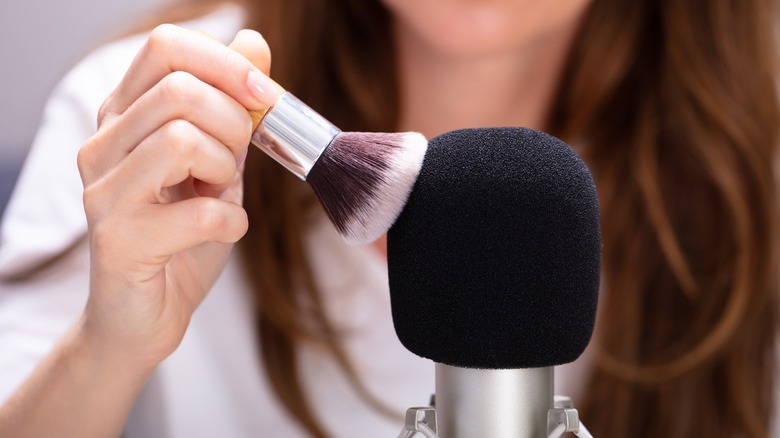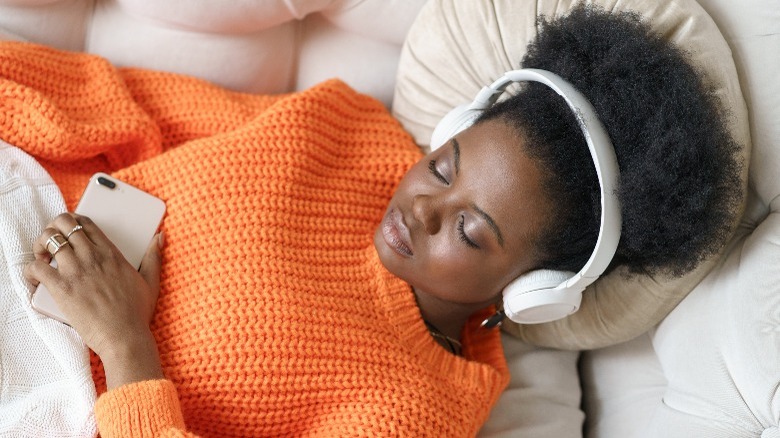Those Silly ASMR Videos You Scroll Past On TikTok Could Be The Key To Unlocking Some Anxiety Relief
Imagine bubbles fizzing in a cracked-open can of soda; the feeling of a makeup brush gliding across your cheek; the sound of nails lightly tapping on a wooden table. What do each of these sensations have in common? All of them are known to instigate one's autonomous sensory meridian response, aka, ASMR. Once a niche video genre in the corners of YouTube, over the past decade, ASMR content has proliferated on the internet. Even if you do not regularly seek out ASMR videos, odds are, it still appears during your scrolling sessions on TikTok. But before we go any further, let's break down what ASMR actually is.
ASMR has different manifestations from person to person, but as the name suggests, it is a feeling caused by a particular "trigger" or stimuli. When someone experiences ASMR — and not everybody does — they might experience a pleasant tingling on the top of their head, raised hairs on their arms, and a feeling of calm and sleepiness. Some people even use ASRM to alleviate the emotional and physical toll of anxiety and depression, per Healthline.
Common ASMR triggers include sounds such as whispering, and visuals such as hand movements, or a combination of the two. More experimental ASMR triggers might include the sound of chewing food, or even cosplaying specific roles. While it works for some, others might find ASMR straight-up silly — even kind of repulsive. Given how popular ASMR has become, is there any actual substance behind the sensation?
What is the appeal of ASMR?
Some people watch ASMR to assist them in falling asleep, others might watch to feel comforted during a bout of depression, or perhaps even to calm them down in the midst of an anxiety attack, according to Healthline. Put simply: ASMR can be much more than making odd noises and tapping on strange objects, although entertainment is also a part of the genre. Where scrolling through your phone at night is a habit to avoid if you want a good night's sleep, listening to ASMR could be an alternative activity. And while ASMR cannot (and should not) replace regular therapy or the guidance of a mental health professional, it has become a tool for those who are seeking relief from mental health issues.
Some ASMR videos are made as guided meditations, or lead listeners through breathing exercises, each in an attempt to bring some relaxation, however short-lived. A 2023 report from KFF and CNN shows that about 50% of adults between the ages of 18 and 24 reported symptoms of anxiety or depression. But with the cost of therapy considered a burden for many, some might turn to more creative coping mechanisms, one of which could be ASMR.
ASMR creators have also inspired massive followings – some of which are in the millions – which have given way to robust online communities as well. Those who enjoy ASMR are able to connect with like-minded people online, which could be another part of the appeal.
What does ASMR science say?
While there is still much more research to be done on what function ASMR serves, and whether or not it can be used to treat certain mental health symptoms including anxiety and depression, the evidence that is available is mounting. Some suggest ASMR is a primitive response to social bonding. One 2022 study published in Experimental Brain Research found that experiencing ASMR can influence a person's mood. After 38 young adults watched ASMR, "depressive feelings" diminished for those who experienced ASMR when watching an ASMR video. Additionally, the heart rate of each subject decreased when watching the video, even when the effects of ASMR were not achieved.
Another 2015 study published by PeerJ Life & Environment Research used a larger research pool, a group of 475 people, to understand why they sought out ASMR content. The study found that almost all of the participants watched ASMR videos for relaxation, the vast majority watched ASMR to help them sleep, and another majority watched ASMR as a stress coping mechanism. This study found that 80% of subjects experienced a mood change after watching an ASMR video. And another group of individuals asserted that watching ASMR helped alleviate symptoms of chronic pain.
Despite the relative lack of empirical evidence, the anecdotal evidence of the benefits of ASMR is not to be ignored. Next time you're about to scroll past an ASMR video, consider enjoying a relaxing tingle or two.


